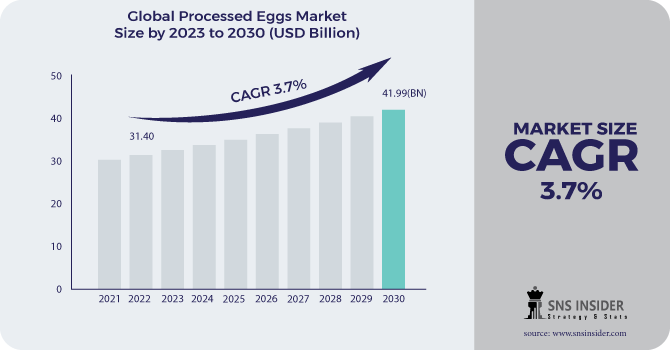Processed Eggs Market Report Scope & Overview:
Processed Eggs Market Size was valued at USD 31.40 billion in 2022 and is anticipated to reach USD 41.99 billion by 2030, and grow at a CAGR of 3.7% over the forecast period 2023-2030.
Eggs are handled by eliminating eggshells and regulating the got fluid item to make it able and appropriate for use in a few food items. The means which are engaged with egg handling are evacuation and breaking of eggshells, filtration, blending and mixing, settling, purifying, freezing or drying, and bundling. These egg variations numerous multiple times contain added fixings (like additives, and varieties) and this takes into consideration extraordinary plans. They are utilized widely in the elements of a few food items, for example, prepared food sources, dairy items, confectionery, chocolates, prepared to-eat, and enhancements of sustenance.

Comfort food has become more famous as the metropolitan populace develops and individuals' ways of life become more occupied. The need to truly break shells and separate different parts of the egg is wiped out with handled eggs. Moreover, handled eggs are all the more effectively treated and purified because of specialized enhancements, guaranteeing wellbeing, the diminished hazard of defilement, and a longer period of usability. Handled eggs are usually used in sports and lifting weights as a wellspring of excellent protein. Moreover, handled eggs can be utilized in new and extraordinary culinary items, like handled eggs and medical services items. It has potential as a helpful type of fixing in the food and refreshment industry for the rising production of staples requiring endlessly egg parts, as it significantly decreases difficult work.
Market Dynamics:
Driving Factors:
-
Accommodation and usability and capacity of handled eggs.
-
The rising metropolitan populace and occupied ways of life.
Restraining Factor:
-
Ascend in the tough food handling guidelines.
-
Tedious administrative arrangements.
Opportunities:
-
Because of mechanical headways, handled eggs are all the more productively treated and sanitized.
-
Confirmation of security, decreased chance of defilement and expanded period of usability.
Challenges:
-
Severe creature government assistance administrative approaches.
Impact of Covid-19:
The effect of COVID-19 flare-up on the deals handled egg has been insignificantly certain, particularly at the times when the lockdown was forced in the vast majority of the regions of the planet which prompted alarm purchasing among the shoppers. The episode additionally advanced the deals of processed egg items through internet business and online staple stages, which likewise portrays that purchasing processed egg items on web-based retail stages is probably going to accomplish the most elevated development during the estimated time frame.
Market Estimation:
Result Type, the call for egg powder is expanding more than fluid egg because of a more drawn-out period of usability, simplicity of transportation, and basic stockpiling.
In the application portion, the food and refreshments fragment controlled the greatest section in the estimated time frame.
Key Market Segmentation:
By Application:
-
Bakery
-
Confectionery
-
Dairy Products
-
Ready-To-Eat Meals
-
Soups & Sauces
-
Others
By Product Type:
-
Dried Egg Products
-
Liquid Egg Products
-
Frozen Egg Products
.png)
Regional Coverage:
-
North America
-
The USA
-
Canada
-
Mexico
-
-
Europe
-
Germany
-
The UK
-
France
-
Italy
-
Spain
-
The Netherlands
-
Rest of Europe
-
-
Asia-Pacific
-
Japan
-
south Korea
-
China
-
India
-
Australia
-
Rest of Asia-Pacific
-
-
The Middle East & Africa
-
Israel
-
UAE
-
South Africa
-
Rest of Middle East & Africa
-
-
Latin America
-
Brazil
-
Argentina
-
Rest of Latin America
-
Regional Analysis:
North America represented the biggest piece of the pie in the worldwide handled eggs market and is supposed to proceed with their comparable development direction during the conjecture time frame. The purchasers in the locale are leaning towards well-being helping items attributable to the rising well-being awareness among shoppers. During the projection time frame, Asia-Pacific is supposed to increment at the quickest rate. Sound ways of life are turning out to be more famous, and customers are inclining toward wellbeing helpful things. The European area is additionally assessed to show extensive interest in the span of the estimated time frame.
Key Players:
Key Players of Egg processed market are Avril, Cal-Maine Foods, Inc., Eurovo S.R.L., Lactosan-Sanovo Holding A/S, Moba B.V., and ACTINI GROUP.
Avril-Company Financial Analysis

| Report Attributes | Details |
|---|---|
| Market Size in 2022 | USD 31.40 Billion |
| Market Size by 2030 | USD 41.99 Billion |
| CAGR | CAGR 3.7% From 2023 to 2030 |
| Base Year | 2022 |
| Forecast Period | 2023-2030 |
| Historical Data | 2020-2021 |
| Report Scope & Coverage | Market Size, Segments Analysis, Competitive Landscape, Regional Analysis, DROC & SWOT Analysis, Forecast Outlook |
| Key Segments | • by Application (Bakery, Confectionery, Dairy Products, Ready-To-Eat Meals, Soups & Sauces, Others) • by Product Type (Dried Egg Products, Liquid Egg Products, Frozen Egg Products) |
| Regional Analysis/Coverage | North America (USA, Canada, Mexico), Europe (Germany, UK, France, Italy, Spain, Netherlands, Rest of Europe), Asia-Pacific (Japan, South Korea, China, India, Australia, Rest of Asia-Pacific), The Middle East & Africa (Israel, +D11UAE, South Africa, Rest of Middle East & Africa), Latin America (Brazil, Argentina, Rest of Latin America) |
| Company Profiles | Avril, Cal-Maine Foods, Inc., Eurovo S.R.L., Lactosan-Sanovo Holding A/S, Moba B.V., and ACTINI GROUP. |
| Key Drivers | •Accommodation and usability and capacity of handled eggs. •The rising metropolitan populace and occupied ways of life. |
| Market Opportunities | •Because of mechanical headways, handled eggs are all the more productively treated and sanitized. •Confirmation of security, decreased chance of defilement and expanded period of usability. |

